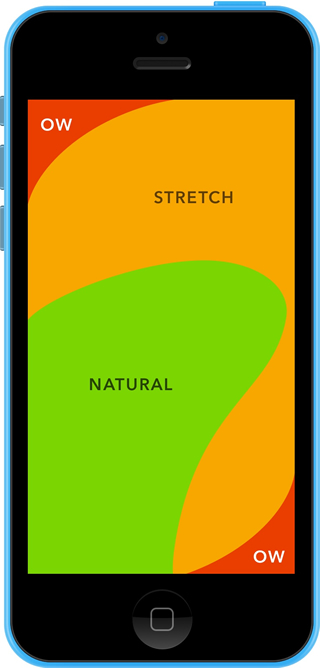https://www.youtube.com/watch?v=mmLY7sOssg0
A new IoT kit is on it’s way. This one is open source, connects to sensors wirelessly and is called Wunderbar.
Graphic created by Ayşe Gökçe Bor.
C is for Cyborg
Where are we going with our wearable technology and what will our future look like?
Open-ended Design
What if we could design products which are flexible enough to allow the user to tinker while using it? An open-ended product promotes freedom of use, for everyone to explore their own interests niche purposes. The exploration process should be playful, focussing on the application without imposing technical constraints which require learning expert skills, which toolkits might do. Staying close to open design principles, this project proposes an alternate way for passionate users to engage with corporations to cooperate in the development process.
Social News
Jacob Cyriac
Jacob’s thesis explores changes in the style and content of news, as social media now plays an increasingly important role in its creation and distribution. How do individuals, who now have infinite choice and the ability to curate what they consume, find a balance between local, global and personal interests?
SlowGround
Slow is the new fast! Ayşe is taking an exploratory path down the slow lane and aims to inspire people to create dialogues around our paces in life. Her project process reflects the topic and she digs in to slow design and participatory design to see what “slow interaction design†may mean.
Blog: http://slowground.wordpress.com/
Organic Farming
“Food production (in Sweden) has fallen by about two percent per year over the last 30 years. If this continues, in 2053 there will be one farmer left.” Marie’s thesis aims to give the future organic farmer a product and system to help maintain control of their data that they produce, collect, and pass on.
Blog: http://mariejohansson.com/thesis.html
Tangible Nutrition
Doris’ thesis is taking a critical perspective on our interactions with food and resulting physical health. She believes the food industry and media confuses human predisposed preferences, creating the necessity for willpower and habit control, thus leading to decision fatigue on healthy food choices in our already busy lives. What if our individual physical needs are satisfied with doses of specific nutrients?
Blog: Â http://makenutritiontangible.wordpress.com/
Alternative Search
Adam is exploring alternative ways of navigating the Web. What if enhancing search tools not only relied on technological development, but exploration of potential user experiences in broader perspectives – which not only gratifies the needs for information, but supports a diversity of journeys.
Open Sesame
As doors are becoming more integrated into our digital infrastructure, we seem to shy away from physically interacting with them. Project ‘Open Sesame’  started as a question of what it is we lose in this process and what a potential role or use of touch could be in future doors. The aim is to explore how touch could add value and play a more active part in increasingly digital doors.
Library Unbound
Siri Johansson’s thesis aims to explore how the library could extend its reach and contribute to making urban life more playful and social. It will do so by considering library books as networked objects (connected to the internet) as well as networking objects (connecting people socially).
Blog: http://sirijohansson.com/thesis/
Social Money: Reimagining Transactions that build Social Capital.
Desmond Wong is investing the meaning of transactions by looking for meaning in transactions. What if social capital was currency, creating a new financial model built on relationships and trust?
Blog: http://www.desdesmond.tumblr.com
Precision Medicine: Future of Data Driven Healthcare
What if genetic and quantified self data was an integrated part of public healthcare? Shelagh McLellan’s thesis aims to provide a vision of precision medicine and the future of data driven healthcare services.
Blog: http://precisionmedicine.wordpress.com/
Karey’s thesis aims to critique and challenge society’s relationship with energy by asking “What if you were required to produce all energy you desire to consume?
Blog: http://www.kareyhelms.com/blog/
Remember to follow the Interaction Design Programme Facebook page for fresh updates from Umeå
Wearable technology, biometric data and a new app for your iPhone. “UP Coffee, the first product from Jawbone Labs, is the simplest way to understand how caffeine affects your sleep.”

You might be aware of Jawbone, the band that tracks your sleep, activity, and eating habits for a healthier living. They just released an app that will influence your relationship with coffee, although its beautiful UI will make you want to have another cup.
iPhone users can download the app here.
A bit about the wrist band:
http://www.youtube.com/watch?v=l3xk48GsPIg
Spritz is an app that presents texts as a 1-word rapid serial visual stream. They designed a reading frame that allows the reader to easily focus on the most critical letter of each word, elimination the need for constant eye movement from one word to the next, to the next…
They claim you can reach speeds of 900 words per minute, where 220 wpm is the average speed when reading the ‘classic’ way. That would mean that you can read through a thick novel in just 1,5 to 2 hours. Try it out:

250 words per minute

500 words per minute
Same as for Twitter and Facebook, this app comes with a new verb: spritzing. On some latitudes this might sound awkwardly familiar, and they seem to be aware of it:
interaction design without screen, the Cone audio player from Aether
http://youtu.be/ZSg-_puiEjU
makes me wonder:
When people’s experience of products starts to be determined by machine-learning algorithms, how does the role and responsibility of the interaction designer change? ( and the skill-set that an interaction design education teaches)
http://www.youtube.com/watch?v=xvT0MCugb58
http://www.youtube.com/watch?v=fsL9Syj3gow
I’m not sure about I buy the “Pizza Hut, a leader in digital innovation” tag line…
Web 3.0, is it?
Stephen Wolfram introduces the Wolfram Language in this video that shows how the symbolic programming language enables powerful functional programming, querying of large databases, flexible interactivity, easy deployment, and much, much more.
Umeå Institute of Design is looking for a Programme Director and Lecturer in Interaction Design.
As Programme Director you are expected to have a strong vision for the future direction of the field and an interest in merging this with the human-centered and hands-on making values that are central to UID’s education.
Application deadline is April 15th, 2014.
Please help us spread the word.
http://www.youtube.com/watch?v=iwSpn7H7vKg
[Update regarding the previous blog post, the design challenge is now open for submission.]
The Intel Make It Wearable challenge will call upon the smartest and most creative minds around the world to move towards the future of wearable devices and ubiquitous computing, such as meaningful usages, aesthetics, battery life, security and privacy. Intel will be awarding more than US$1.3 million cash awards to winners and will also be connecting contenders with industry luminaries to help realize their ideas.
Unfortunately Sweden is not on the list of participating countries, but many of the international students and alumni might be able to participate via their home country affiliation. Residents of Argentina, Canada, Chile, PRC China, Colombia, Denmark, Egypt, Finland, France, Germany, India, Ireland, Israel, Japan, Kenya, Mexico, Poland, Russia, Spain, South Korea, Switzerland, Taiwan, Turkey, The United Kingdom and USA are good to go.
Read more at http://makeit.intel.com and http://thecreatorsproject.vice.com/blog/make-it-wearable
A taxonomy of design representations used by industrial designers with 32 types of sketch, drawing, model and prototype that identifies when they are used and for what types of information. More info on this page.
By Dr Mark Evans and Dr Eujin Pei.
iD Cards app for iPhone / iPad and iPod Touch (iTunes)
iD Cards app for Android (Google Play)
Do you want to work with us in pushing the boundaries of design research?
We are searching for an Assistant Professor (forskarassistent) to join us in our ambition to create a research environment that can take industrial design further into the future. It is a four-year position consisting of predominantly research, but with a possibility to build tutoring and pedagogical merits with up to 20% of the employment. The employment offers a unique career opportunity, with the explicit intention that the holder will identify, develop and establish a long-term research agenda with a strong contribution both locally to the school and internationally to the design research community at large.
http://uid.umu.se/en/about-us/job-opportunities/assistant-professor-in-industrial-design/
A nice post from blogger and author Scott Hurff about Facebook’s recent UI debut, ‘Paper’. Ouch!
An inspiring movie about health and the future of wearable technology.

Most designers today create static mockups to communicate app ideas. But increasingly apps are anything but static, which means as designers we need a better tool for interaction design.
Origami is a free toolkit for Quartz Composer—created by the Facebook Design team—that makes interactive design prototyping easy and doesn’t require programming.




